Uncanny X-Men Part 8, Issues 59-66: The Savage Land and the End of the Silver Age X-Men
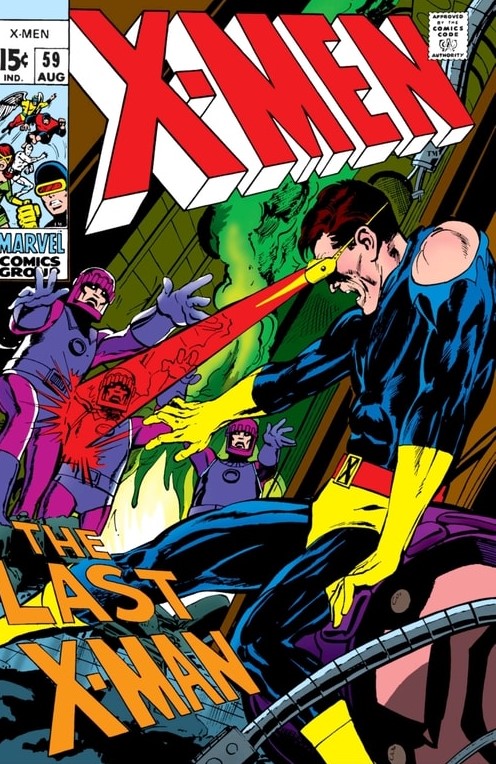
This is a gigantic milestone! This is the 8th episode in my reread of the X-Men run. It covers from #59, the height of the Roy Thomas-Neal Adams run, to #66, the end of original X-Men stories, which hit the stands on March 10th, 1970. The end of the X-Men’s ongoing stories coincides with the end of the Silver Age and the beginning of the Bronze.
The Silver Age X-Men, as a distinctly 1960s phenomenon reached their peak with some of the Arnold Drake stories with some interesting experimentation under Steranko’s art. The arrival of Neal Adams feels much more like it belongs in the Bronze Age. Both the art and the story complexity (under Roy Thomas) feels like it’s breaking creative ground that the best of the 1970s will follow.
The merry mutants’ uneven momentum had carried them for 7 years, but even a spectacular finish couldn’t save the series from its failure to come into focus. We’re going to talk today about that end.
Why did X-Men have to end? If you look at the 1969 sales figures at Comichron a modern reader will think that an average of 235,000 sales per issue is good. But the gigantic 1960s newsstand market is not the fragmented direct comic store market we have now. In this boom period of periodicals, if some other magazine could sell more, publishers would stop producing comics and go in that direction. Or distributors might insist on more favorable terms for themselves. There were also severe structural problems with return policies that encouraged a fair bit of pirating.
On that chart in that link, you’ll also notice that at the 26th ranking, X-Men was behind every other Marvel title published in 1969. And Marvel only had one title in the top ten: Amazing Spider-Man. The Silver Age had had its hits and misses as DC and Marvel struggled to figure out by trial and error and letters from fans what worked in this new super-hero genre. The decision to turn X-Men into a reprint title as of issue #67 was no doubt a sound one from a business point of view – Marvel incurred no new creative costs nor risked missed deadlines or uneven fill-in art, and even if they sold half as many, they still likely made more on each issue.
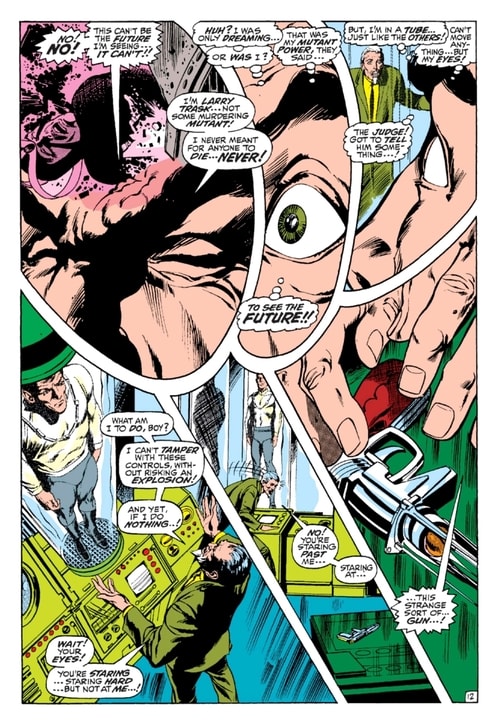
Still, no one can say that X-Men didn’t finish with a bang. We’d left off on a bit of a cliffhanger in the 7th blog post – with Alex Summers and many mutants captured by the Sentinels who were running wild with no humans in charge. Issue #59 ends the storyline that began in issue #54, with Beast, Marvel Girl and Cyclops sneaking into the Sentinels’ fortress disguised as Toad, Scarlet Witch and Quicksilver respectively. The Sentinels’ surprise is very satisfying and the defeat of the mutant-hunting robots moderately so (Cyclops convinces them to fly into the sun?).
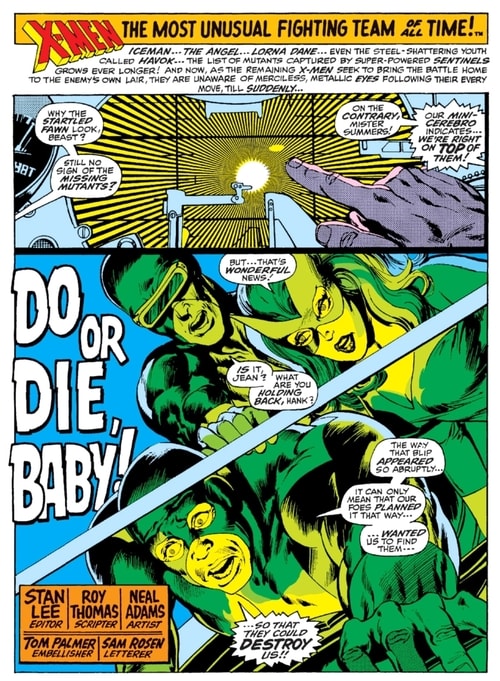
However, Alex Summers has been gravely injured. Looking through Professor X’s notes, they find a reference to Dr. Karl Lycos. They bring Alex to him and leave him for treatment. We the audience see that in fact, Lycos is a non-mutant variant – he absorbs energy from others, and when he absorbs energy from mutants, who have more, he turns into a big dinosaur creature that calls itself Sauron, after the greatest evil character in literature….
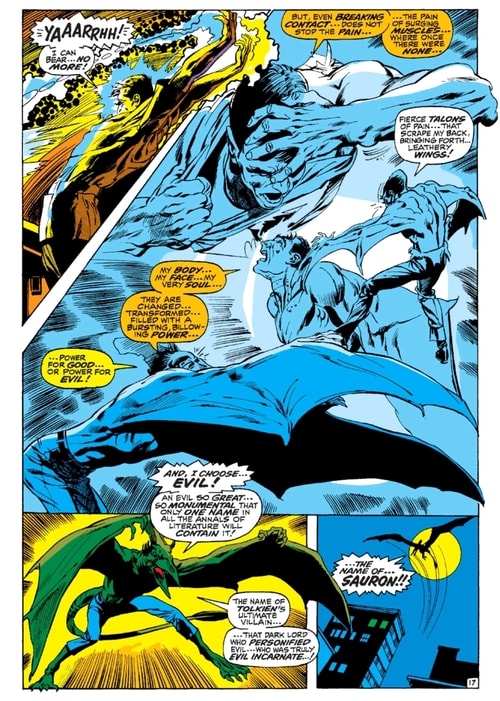
OK. Let’s unpack a few things here…
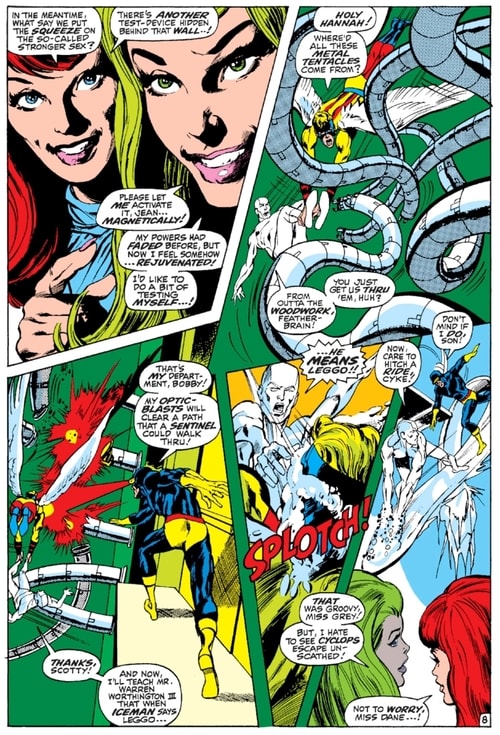
Roy Thomas not only read a lot of Golden Age comics, but he was well-versed in the pulps, and he would have been just out of university when Tolkeinmania hit. So the call-out to the Lord of the Rings villain is not so surprising. It feels silly when you read Sauron’s reasoning, but Sauron is now firmly and justifiably entrenched in the Marvel Universe as one of its great villains, with his thematic links to the Savage Land and to mutantkind.
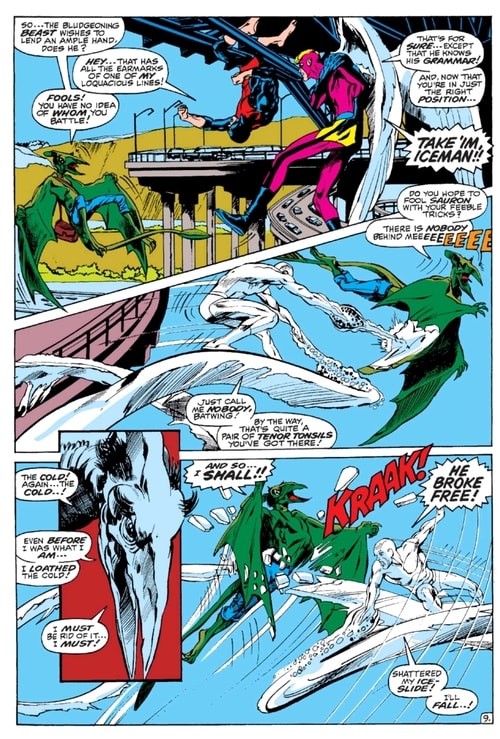
Sauron’s creation by Thomas and Adams deserves a moment’s diversion too, because it too is a product of the circumstances of the time. Thomas and Adams wanted a vampire villain for the story, but this was the period of the Comics Code, which forbid any depiction of the undead. Sauron can hypnotize people, like a vampire (and Mesmero, introduced only 10 issues earlier).
But instead of draining blood, Adams and Thomas’ vampire sucks life energy from its victims. And instead of turning into a bat, Lycos turns into a pterodactyl. The restriction of the Comics Code actually forced Thomas and Adams to come up with something much more original and enduring. It’s worth noting that Moebius the Living Vampire is a product of the same strategy — you can see why “living” is even part of his title.
In these pages, you can see a lot of the artistic experimentation Adams was bringing to comics, from the hyper-realism to new dynamic layouts. The double-page spread below is a wonderful example of Adams literally thinking outside of conventional comic boxes.
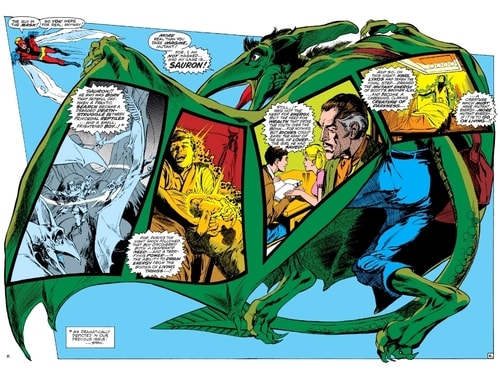
The X-Men don’t get a clean win on Sauron. Because Lycos is worried about inflicting his hunger on his fiance, he flees, all the way back to Tierra Del Fiego in Chile, where he was originally first infected with lycanthropy, determined to die alone to save the woman he loves. Compared to the rest of the Silver Age, this is sophisticated writing and plotting and character work so kudos to Thomas. It wasn’t that Marvel hadn’t made villain-to-hero stories one of their calling cards (think Hawkeye, Scarlet Witch, Quicksilver, etc), but this isn’t a complete journey from villain to hero — Lycos remains a dangerous and selfish man — he just loves his fiance. When his fiance finds him (with the X-Men), Lycos throws himself over a cliff to save her.
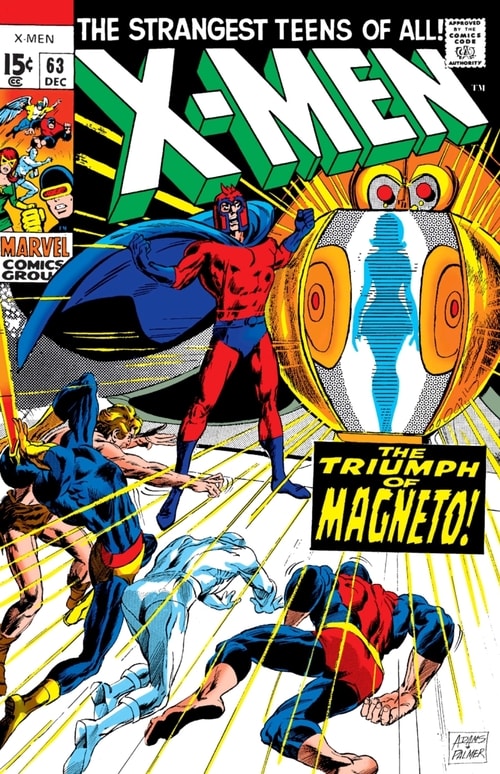
The next issue opens with a bang again – Angel had been following Lycos’s fall, trying to recover the body, but he’d just kept going down and down, through deeper caves, until he was attacked by dinosaurs and finally plunged to his death in the underground Savage Land. Angel is found by a kindly high-tech figure who uses his machines to bring Angel back to life (and give him my favorite Angel costume — thank you Neal Adams for the new character design!). It turns out that this kindly guy has been finding misfits in the Savage Land and saving them from persecution by fearful others. He’s obviously a Professor X figure and he needs Angel to stop the X-Men from attacking him.
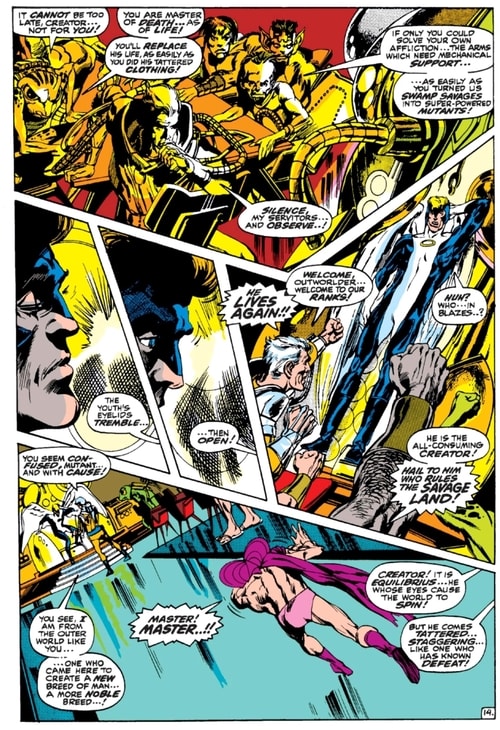
Needless to say, Warren hasn’t fallen far from the Professor X tree and he goes to battle his own teammates to make them see the real context of this weird civil war in the Savage Land.
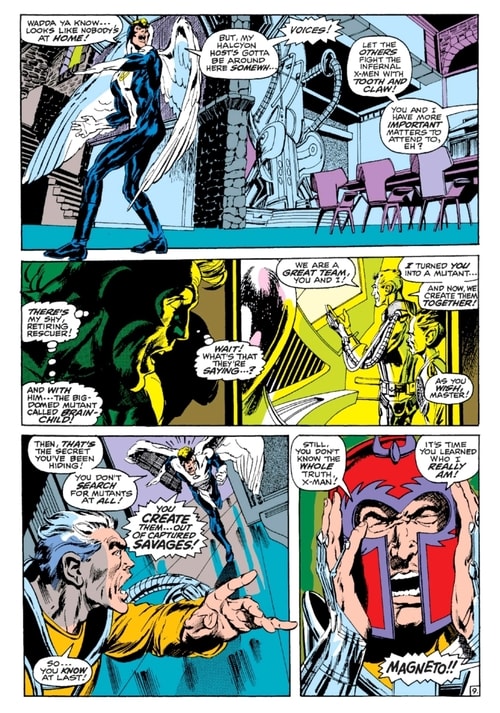
But of course, Angel has been duped. The kindly old high-tech man is Magneto, slowly recovering his power after his defeat in the X-Men-Avengers cross-over (covered in my 5th X-Men post, see below). Magneto has actually been taking people from the Savage Land and mutating them into a conquering army.
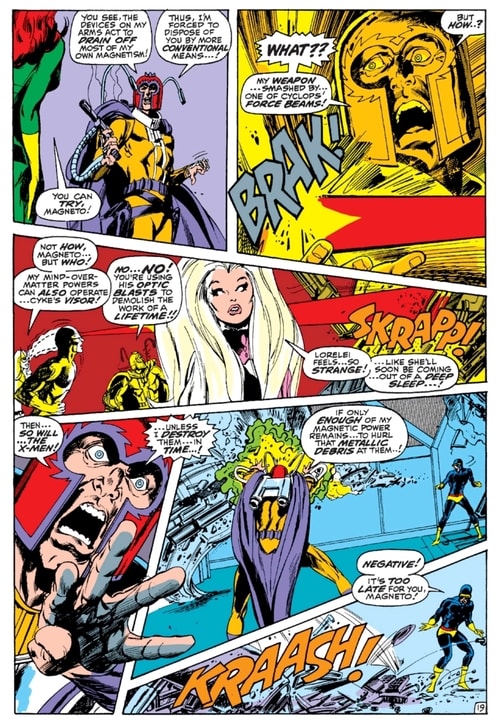
Magneto’s greatest weapon is Lorelei, who can hypnotize all male creatures (the 3rd hypnotist in 14 issues!), so 80% of the X-Men turn into mush. That’s when Marvel Girl takes center stage and goes toe-to-toe with Magneto. She uses her telekinesis to damage Magneto’s machines, but he manages to stop her, even with his weakened powers. But Marvel Girl is no dummy — Cyclops may be hypnotized, but she telekinetically turns his head and opens his visor, breaking all of Magneto’s toys, which he needed to control his new mutates.
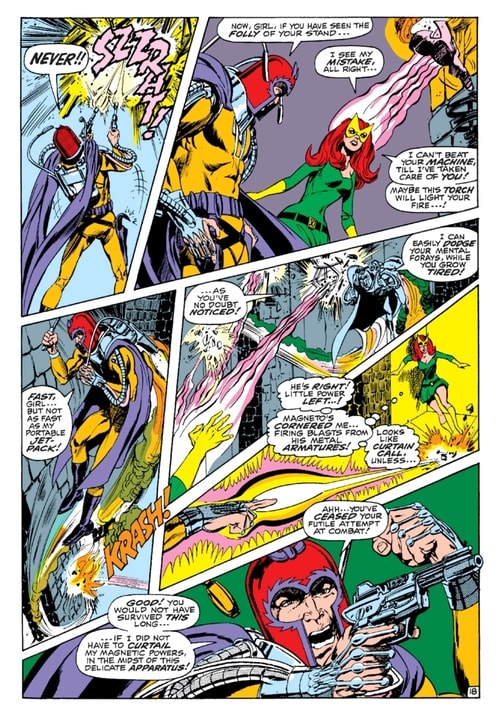
Boom. Don’t mess with Marvel Girl.
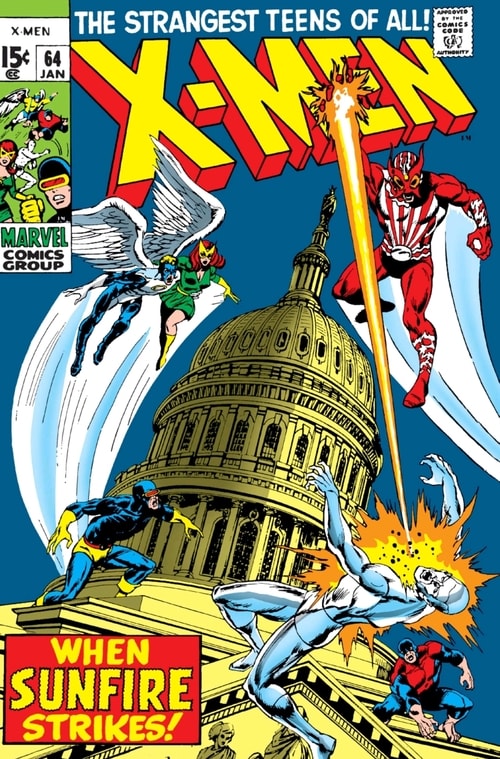
Issue #64 introduces the Japanese mutant Sunfire in a story firmly in the theme of the atomic age. Although Don Heck is pencilling, Tom Palmer’s inks really smooth out Heck’s flaws and texture the art beautifully. And then comes issue #65, one of the most consequential ones of the original X-Men run.
In this issue, it is revealed that Professor X didn’t die — it had been Changeling (remember him from Factor Three?) who had been dying and seeking redemption. Sometime around issue #40, Changeling took on the role of Professor X so that the X-Men’s leader could focus all his powers on preparing for a world-level threat.
And now that threat has arrived and Marvel Girl (who knew the truth all this time) can finally stop holding up the charade. It’s a weird set-up, but for comics effective. And the alien threat is a great one, and especially as it’s drawn by Adams.
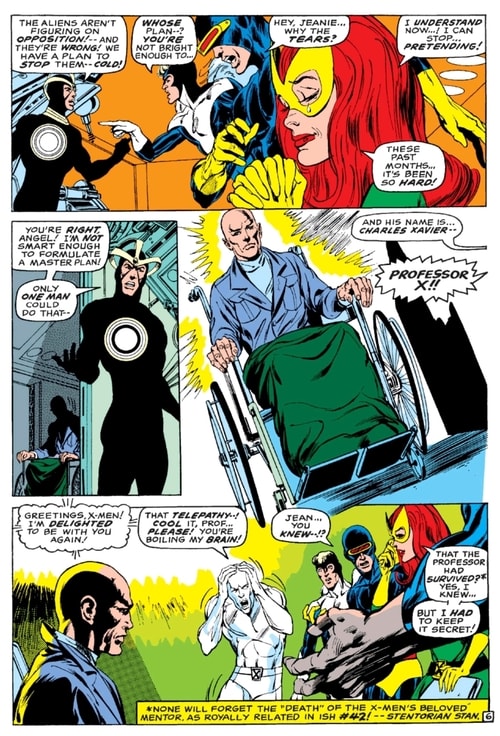
The X-Men need to board the X’Nox ship and hold off the invading aliens for a while as Professor X harnesses and focuses the psionic will of the entire planet Earth to drive the aliens back. It’s a neat story and reunites the X-Men with their teacher, who is a pillar of the X-Men’s whole design. They had some great stories without a teacher, but it feels like everything is back in place now.
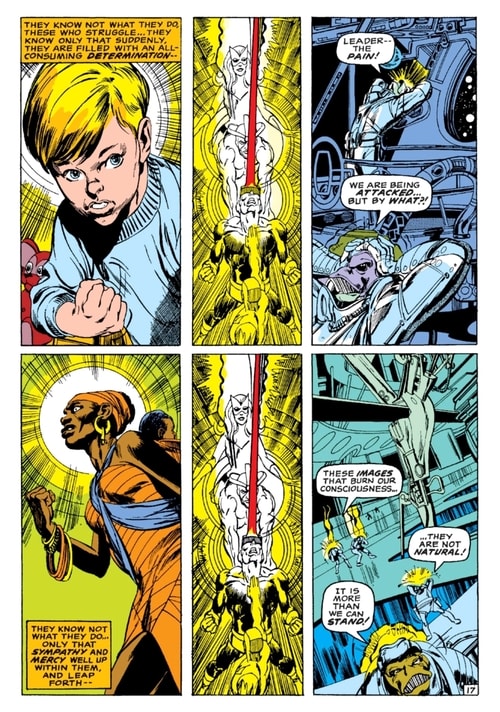
After the bigness of that story and the stellarness of the art, the last issue, #66, is an unfortunate let-down. Sal Buscema is on art duties, and while I found him fine for some Bronze Age work like The Incredible Hulk, occasionally The Defenders, and second-string titles like Nova or Son-of-Satan, I rarely get excited by Buscema’s style. And the story feels like filler — the X-Men have to find Bruce Banner and persuade him to give them some tech to save the professor from a consequence of the previous issue.
It’s fighty-fighty and if I were 10 years old, I would have been pleased with its workmanlike execution. The cover looks like Marie Severin and its bursting colors and energy would certainly have any self-respecting 10-year old pulling off the spinner rack.
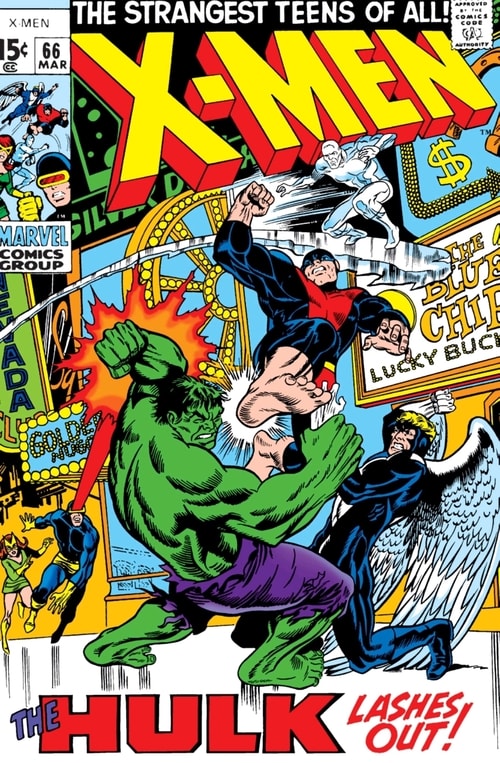
And that’s sort of the limp ending of the original X-Men, at least as a series.
I’m not gonna lie. The ending of the original X-Men run is a bittersweet experience. I came to Uncanny X-Men close to the dawn of its classic Claremont/Byrne/Cockrum period, during my own life’s Golden Age (10 years old). So for me, the Silver Age was a distant and yet (due to Marvel’s heavy continuity) close era.
I love it, warts and all. I guess part of it too is that I grew up in a world with a finite X-Men supply. When I was buying issue #154 in the corner store in December of 1981, there were literally only about 120 X-Men stories in existence! It’s not like being in 2020 with maybe a thousand if you add up all X-Men, Uncanny X-Men, X-Factor, New Mutants, and so on and so on, to say nothing of the Wolverine titles. Even if some Silver Age stories were uneven, they were the only game in town. Rereading the X-Men is an exercise in nostalgia and pop culture archeology, in revisiting long-lost relatives, in time travel through literature and through self. I’m really glad I did it, and with the kind of imposed reflection needed to also communicate my experience.
I’m not going to stop though. X-Men was a reprint book from #67 – #93, but at the end of 1975, Len Wein and Dave Cockrum started a new era. In between, the X-Men made some guest appearances here and there that I want to reread, or at least touch on. And later creators went back to that lost era, notably John Byrne with his X-Men: The Hidden Years. I’d like to look at those in story order before finally getting to the new X-Men.
Hopefully, some of you will join me on the next leg of this ride. If you want to catch up on any of my other posts about the X-Men, they’re below:
- Part 0: A Fresh Look at X-Men Continuity: Ed Piskor’s Grand Design
- Part I: Introducing The Strangest Super-Team of All: Uncanny X-Men #1 (Nov 1963) to #20 (May 1966)
- Part II: Early Guest Appearances (1964-65), Uncanny X-Men #21-23 (1966), and X-Men: First Class Volume I (2006)
- Part III: X-Men: First Class, Volume II (2007) and First Class Finals
- Part IV: Uncanny X-Men #24-39: The Middle Years of the Original Team
- Part V: Uncanny X-Men #40-48: Death and Separation
- Part VI: Uncanny X-Men #49-53: Reunion and Family and Steranko
- Part VII: Uncanny X-Men #54-58 — Havok and Neal Adams
- Part VIII: Uncanny X-Men #59-66: The Savage Land and the End of the Silver Age X-Men
- Part IX: Filling in the Corners of the Original X-Men with Savage Hulk #1-4
- Part X: John Byrne’s The Hidden Years #1-4
- Part XI: Storm, the FF and Phoenix in John Byrne’s The Hidden Years
- Part XII: X-Men Guest Appearances in 1971-1972 and Hank gets Furry!
- Part XIII: Englehart’s Bronze Age Monster Horror – The Beast
- Part XIV: 1973 and 1974 – Magneto, the Hulk, Banshee and post-Watergate Captain America
- Part XV: 1974 and 1975 – The Last Tales of the Original X-Men
- Part XVI: Enter Wein, Claremont and Cockrum in 1975
- Part XVII: 1976 — Sentinels in Space and the Rise of Phoenix
- Part XVIII: Juggernaut and Magneto — For the Very First Time
- Part XIX: Phoenix, Firelord and the Imperial Guard
- Part XX: Iron Fist, Blame Canada and Some Strike-Outs
- Part XXI: Epic Magneto Triumph and more X-Men Death!
- Part XXII: 1978 — The Savage Land, Japan and Psionic Throwback Thursday!
- Part XXIII: 1979 — Chaos in Canada with Alpha Flight!
- Part XXIV: Arcade, Murderworld and their First King-Sized Annual
- Part XXV: The Proteus Saga and My First Comics!
Derek Künsken writes science fiction in Gatineau, Québec. His first novel, The Quantum Magician, a space opera heist, was a finalist for the Locus, Aurora and Chinese Nebula awards. Its sequel, The Quantum Garden is on sale now. His third novel, The House of Styx, has just been announced jointly by Solaris Books and Analog Science Fiction and Fact who will be publishing it in hardcover and serial form, respectively. The serialized version hit stands last month with this amazing cover!
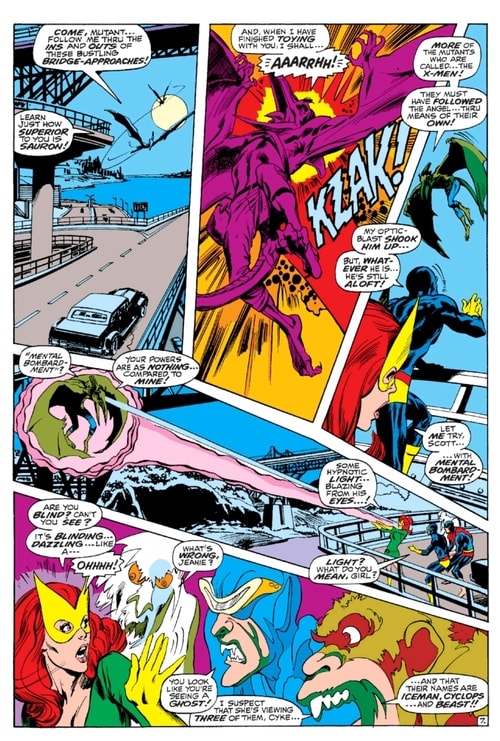
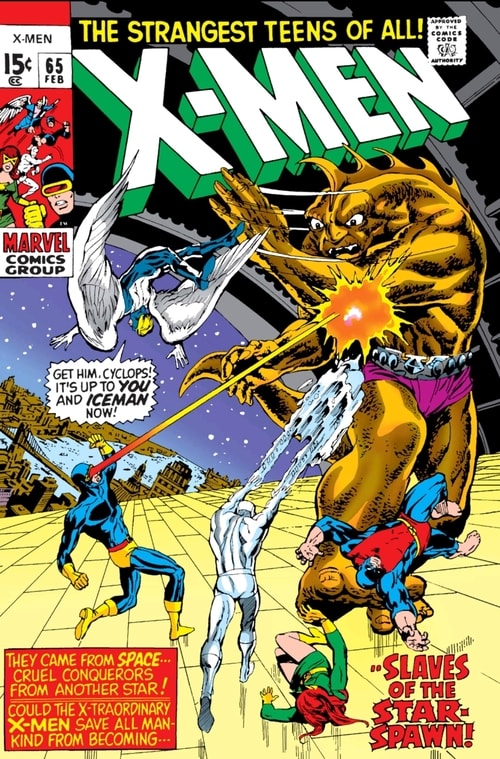
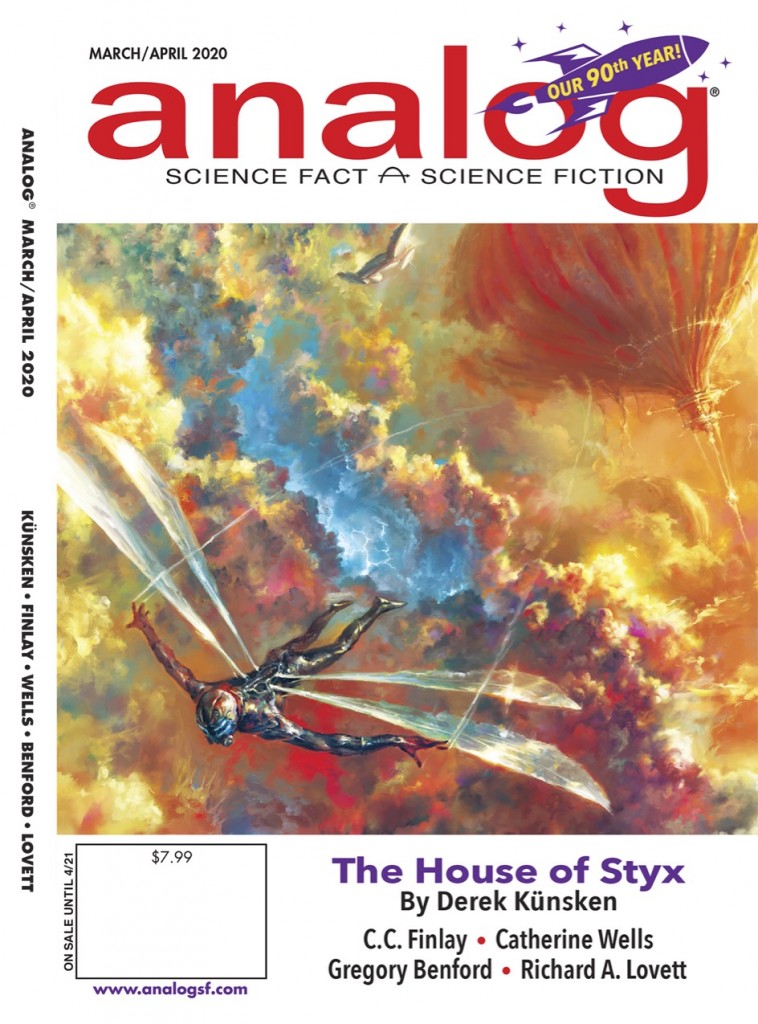
Naming the villain “Sauron” was one of a number of Tolkien references that delighted me back when these comics first appeared. Last year I wrote an article for a monthly Tolkienian newsletter on the topic:
“Days of the Craze #30: Marvel Comics Group Beats DC to the Tolkien Punch.” Beyond Bree March 2019: 6-7.
Marvel revived the Black Knight as a sword-and-sorcery hero, and his winged horse was now named Aragorn.
Aside from in-jokes in Not Brand Echh, etc., there was the Serpent Crown serial in the Sub-Mariner comic (issues 9, 10, 12, 13, with cover dates from January-August 1969). This story showed more actual Tolkienian influence than the X-Men “Sauron” sequence.
It’s the 87th issue of the House of Secrets comic, dated Aug.-Sept. 1970, that contains DC’s first Tolkienian allusion – so far as I know.
Marvel got in first, with a joke in Not Brand Echh #4 (on sale in August 1967) — tengwar on Stuporman’s chest.
Dale Nelson
Hey Dale!
I’d known about Aragorn, but hadn’t known about those other Tolkein references. That’s cool.
Derek